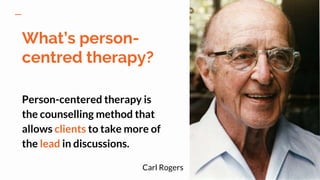Carl Rogers' concept of client-centered therapy, also known as person-centered therapy, was introduced in the 1950s and has since become a widely influential approach in the field of psychology. At the heart of this approach is the belief that individuals have an innate capacity for self-direction and self-actualization, and that the therapeutic relationship should be based on empathy, congruence, and unconditional positive regard.
In client-centered therapy, the therapist's role is to create a safe, non-judgmental, and accepting environment in which the client can explore and express their thoughts, feelings, and experiences. The therapist helps the client to identify and understand their emotions, recognize their own self-worth, and develop new insights and perspectives. The therapist does not impose their own views or beliefs on the client, but rather helps the client to find their own solutions and develop their own sense of self.
One key aspect of client-centered therapy is the concept of empathy. Rogers believed that when a therapist is able to genuinely understand and resonate with the client's experiences and emotions, it can create a sense of trust and validation that is essential for therapeutic progress. To demonstrate empathy, the therapist must be fully present and attentive to the client, and communicate their understanding through verbal and nonverbal cues.
Another important aspect of client-centered therapy is congruence, or authenticity. Rogers believed that it is essential for the therapist to be genuine and transparent in their interactions with the client. This means being honest about one's own feelings and thoughts, and not hiding behind a facade of perfection or neutrality. By being congruent, the therapist can create a sense of trust and openness that is essential for the therapeutic process.
Finally, client-centered therapy emphasizes the importance of unconditional positive regard, or the acceptance of the client as a whole person, without judgment or evaluation. Rogers believed that when a client feels accepted and valued for who they are, it can facilitate a deeper sense of self-worth and self-acceptance. By providing unconditional positive regard, the therapist can help the client to feel safe and accepted, which can be a crucial step in their personal growth and development.
In conclusion, Carl Rogers' concept of client-centered therapy is based on the belief that individuals have an innate capacity for self-direction and self-actualization, and that the therapeutic relationship should be based on empathy, congruence, and unconditional positive regard. By creating a safe, non-judgmental, and accepting environment, the therapist can help the client to identify and understand their emotions, recognize their own self-worth, and develop new insights and perspectives. This approach has been widely influential in the field of psychology and continues to be an important part of many therapeutic approaches today.







